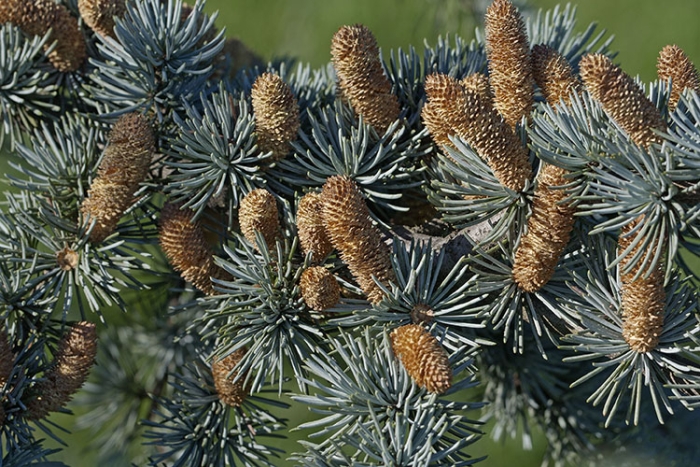Atlas Cedar
(Cedrus atlantica)
Atlas Cedar (Cedrus atlantica)
/
/

Dr. Nick V. Kurzenko
Public Domain
Image By:
Dr. Nick V. Kurzenko
Recorded By:
Copyright:
Public Domain
Copyright Notice:
Photo by: Dr. Nick V. Kurzenko | License Type: Public Domain | License URL: http://creativecommons.org/licenses/publicdomain/ | Attribution: 2015 Nick Kurzenko | Publisher: Calphotos |





















































































































Estimated Native Range
Summary
Cedrus atlantica, commonly known as Atlas Cedar, is an evergreen tree native to the Atlas Mountains in Morocco and Algeria, where it thrives in mountainous regions, often forming forests or woodlands at high altitudes. It typically grows to a height of 40-60 feet (12-18 meters) and a width of 30-40 feet (9-12 meters). The Atlas Cedar has a conical to broadly pyramidal shape with a massive trunk and horizontal to ascending branches that create a majestic silhouette. Its needles are bluish-green to silvery-blue, especially in the ’Glauca’ group cultivars, and it produces barrel-shaped cones. The tree is known for its striking blue-green foliage and its ability to adapt to various climates, making it a popular ornamental tree in temperate regions.
The Atlas Cedar is valued for its drought tolerance and ability to withstand hot conditions better than most conifers, making it suitable for xeriscaping. It is widely used in parks, large gardens, and as a specimen tree. The tree requires full sun and can tolerate a range of soil types, provided they have good drainage. It is available in several cultivar forms, including ’Glauca’ with blue-grey needles, ’Fastigiata’ with an upright, columnar habit, ’Pendula’ with weeping branches, and ’Aurea’ with golden foliage. Gardeners should be aware that Atlas Cedar can suffer from root rot in poorly drained soils and may be susceptible to certain pests, such as aphids and borers. It is also important to note that the tree can become quite large, so it should be given ample space to grow.CC BY-SA 4.0
The Atlas Cedar is valued for its drought tolerance and ability to withstand hot conditions better than most conifers, making it suitable for xeriscaping. It is widely used in parks, large gardens, and as a specimen tree. The tree requires full sun and can tolerate a range of soil types, provided they have good drainage. It is available in several cultivar forms, including ’Glauca’ with blue-grey needles, ’Fastigiata’ with an upright, columnar habit, ’Pendula’ with weeping branches, and ’Aurea’ with golden foliage. Gardeners should be aware that Atlas Cedar can suffer from root rot in poorly drained soils and may be susceptible to certain pests, such as aphids and borers. It is also important to note that the tree can become quite large, so it should be given ample space to grow.CC BY-SA 4.0
Plant Description
- Plant Type: Tree
- Height: 40-60 feet
- Width: 30-40 feet
- Growth Rate: Moderate
- Flower Color: N/A
- Flowering Season: Non-Flowering
- Leaf Retention: Evergreen
Growth Requirements
- Sun: Full Sun
- Water: Medium
- Drainage: Slow, Medium, Fast
Common Uses
Bird Garden, Deer Resistant, Drought Tolerant, Rabbit Resistant, Rock Garden, Salt Tolerant, Street Planting
Natural Habitat
Mountainous regions, often forming forests or woodlands at high altitudes
Other Names
Common Names: Atlantic Cedar, Atlas Cedar, Atlaszeder, Cèdre De L’Atlas, Cedro Dell’Atlante, Bei Fei Xue Song
Scientific Names: , Cedrus atlantica, Cedrus atlantica var. glauca, Cedrus atlantica f. glauca, Cedrus atlantica f. fastigiata, Cedrus libani subsp. atlantica, Cedrus argentea, Abies atlantica, Cedrus libanotica subsp. atlantica, Pinus atlantica
GBIF Accepted Name: Cedrus atlantica (Endl.) Manetti ex Carriere